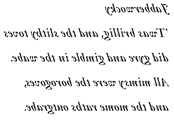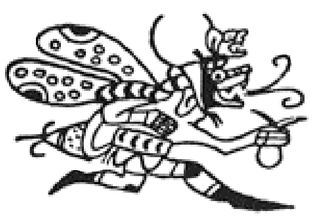The New Drawing on the Right Side of the Brain (11 page)
Read The New Drawing on the Right Side of the Brain Online
Authors: Betty Edwards

BOOK: The New Drawing on the Right Side of the Brain
5.32Mb size Format: txt, pdf, ePub
Today, educators are increasingly concerned with the importance of intuitive and creative thought. Nevertheless, school systems in general are still structured in the left-hemisphere mode. Teaching is sequenced: Students progress through grades one, two, three, etc., in a linear direction. The main subjects learners study are verbal and numerical: reading, writing, arithmetic. Nowadays, however, seats often are set circles rather than in rows. Time schedules are more flexible. But learners still converge on “correct” answers to often-ambiguous questions. Teachers still give out grades that often are tied to the “bell curve,” which guarantees that one-third of every group will be judged “below average,” regardless of achievement. And everyone senses that something is amiss.
The right brain—the dreamer, the artificer, and the artist—is lost in our school system and goes largely untaught. We might find a few art classes, a few shop classes, something called “creative writing,” and perhaps courses in music; but it’s unlikely that we would find courses in imagination, in visualization, in perceptual or spatial skills, in creativity as a separate subject, in intuition, in inventiveness. Yet educators value these skills and have apparently hoped that students would develop imagination, perception, and intuition as natural consequences of training in verbal, analytic skills.
Fortunately, such development often does occur almost in spite of the school system—a tribute to the survival capacity of creative abilities. But the emphasis of our culture is so strongly slanted toward rewarding left-brain skills that we are surely losing a very large proportion of the potential ability of the other halves of our children’s brains. Scientist Jerre Levy has said—only partly humorously—that American scientific training through graduate school may entirely destroy the right hemisphere. We certainly are aware of the effects of inadequate training in verbal, computational skills. The verbal left hemisphere never seems to recover fully, and the effects may handicap students for life. What happens, then, to the right hemisphere that is hardly trained at all?
Perhaps now that neuroscientists have provided a conceptual base for right-brain training, we can begin to build a school system that will teach the whole brain. Such a system will surely include training in drawing skills—an efficient, effective way to teach thinking strategies suited to the right brain.
Handedness, left or rightStudents ask many questions about left- and right-handedness. This is a good place to address the subject, before we begin instruction in the basic skills of drawing. I will attempt to clarify only a few points, because the extensive research on handedness is difficult and complicated.
First, classifying people as strictly left-handed or right-handed is not quite accurate. People range from being completely left-handed or completely right-handed to being completely ambidextrous—that is, able to do many things with either hand, without a decided preference. Most of us fall somewhere on a continuum, with about 90 percent of humans preferring, more or less strongly, the right hand, and 10 percent preferring the left.
The percentage of individuals with left-hand preference for handwriting seems to be rising, from about 2 percent in 1932 to about 11 percent in the 1980s. The main reason for this rise is probably that teachers and parents have learned to tolerate left handed writing and no longer force children to use the right hand. This relatively new tolerance is fortunate, because forcible change can cause a child to have serious problems, such as stuttering, right/left directional confusion, and difficulty in learning to read.
“To make biological survival possible, Mind at Large has to be funneled through the reducing valve of the brain and nervous system. What comes out the other end is a measly trickle of the kind of consciousness which will help us to stay alive on the surface of this particular planet. To formulate and express the contents of this reduced awareness, man has invented and endlessly elaborated those symbol-systems and implicit philosophies which we call languages.”
—Aldous Huxley
The Doors of Perception
The Doors of Perception
Some famous individuals usually classified as left-handers:
Charlie Chaplin
Judy Garland
Ted Williams
Robert McNamara
George Burns
Lewis Carroll
King George VI of Britain
W. C. Fields
Albert Einstein
Billy the Kid
Queen Victoria
Harry S. Truman
Casey Stengel
Charlemagne
Paul McCartney
Pharoah Rameses II
Cole Porter
Gerald Ford
Cary Grant
Ringo Starr
Prince Charles
Benjamin Franklin
Julius Caesar
Marilyn Monroe
George Bush
Mirror writing reverses the shape of every letter and is written from right to left—that is, backwards. Only when held up to a mirror does it become legible for most readers:

The most famous mirror-writer in history is the Italian artist, inventor, and left-hander Leonardo da Vinci. Another is Lewis Carroll, left-handed author of
Alice’s Adventures in Wonderland
and its sequel,
Through the Looking-Glass and What Alice Found There,
whose mirror-written poem is shown above.
Alice’s Adventures in Wonderland
and its sequel,
Through the Looking-Glass and What Alice Found There,
whose mirror-written poem is shown above.
Most right-handers find mirror writing difficult, but it is quite easy for many left-handers.
Try writing your signature in mirror writing.
A useful way to regard handedness is to recognize that hand preference is the most visible outward sign of how an individual’s brain is organized. There are other outward signs: eyedness (everyone has a dominant eye, used in sighting along an edge, for example) and footedness (the foot used to step off a curb or to start a dance step). The key reason for not forcing a child to use the nonpreferred hand is that brain organization is probably genetically determined, and forcing a change works against this natural organization. Natural preference is so strong that past efforts to change left-handers often resulted in ambidexterity: children capitulated to pressure (in the old days, even punishment) and learned to use the right hand for writing but continued to use the left for everything else.
Moreover, there is no acceptable reason for teachers or parents to force a change. Reasons proffered run from “Writing with the left hand looks so uncomfortable,” to “The world is set up for right-handers and my left-handed child would be at a disadvantage.” These are not good reasons, and I believe they often mask an inherent prejudice against left-handedness—a prejudice now rapidly disappearing, I’m happy to report.
Putting prejudice aside, there are important differences between left-handers and right-handers. Left-handers are generally less lateralized than right-handers. Lateralization means the degree to which specific functions are carried out almost exclusively by one hemisphere. For example, left-handers more frequently process language in both hemispheres and process spatial information in both hemispheres than do right-handers. Specifically, language is mediated in the left hemisphere in 90 percent of right-handers and 70 percent of left-handers. Of the remaining 10 percent of right-handers, about 2 percent have language located in the right brain, and about 8 percent mediate language in both hemispheres. Of the remaining 30 percent of left-handers, about 15 percent have language located in the right brain, and about 15 percent mediate language in both hemispheres. Note that individuals with right-hemisphere language location—termed right-hemisphere dominance, since language dominates—often write in the “hooked” position that seems to cause teachers so much dismay. Scientist Jerre Levy has proposed that hand position in writing is another outward sign of brain organization.
Do these differences matter? Individuals vary so much that generalizations are risky. Nevertheless, experts agree in general that a mixture of functions in both hemispheres (that is, a lesser degree of lateralization) creates the potential for conflict or interference. It is true that left-handers statistically are more prone to stutter and to experience the reading difficulty called dyslexia. However, other experts suggest that bilateral distribution of functions may produce superior mental abilities. Left-handers excel in mathematics, music, and chess. And the history of art certainly gives evidence of an advantage for left-handedness: Leonardo da Vinci, Michelangelo, and Raphael were all left-handed.
Former United States Vice President Nelson Rockefeller, a changed left-hander, had difficulty reading prepared speeches because of a tendency to read backward from right to left. The cause of this difficulty may have been his father’s unrelenting effort to change his son’s left-handedness.
“Around the family dinner table, the elder Mr. Rockefeller would put a rubber band around his son’s left wrist, tie a long string on it and jerk the string whenever Nelson started to eat with his left hand, the one he naturally favored.”
—Quoted in
The Left-
Handers’ Handbook
by J. Bliss and J. Morella,
1980
The Left-
Handers’ Handbook
by J. Bliss and J. Morella,
1980
Eventually, young Nelson capitulated and achieved a rather awkward ambidextrous compromise, but he suffered the consequences of his father’s rigidity throughout his lifetime.

Aztecs in early Mexico used the left hand for medicine for kidney trouble, the right when curing the liver.

The Incas of ancient Peru considered left-handedness a sign of good fortune.

Mayan Indians were pro-right: the twitching of a soothsayer’s left leg foretold disaster.
Other books
In the Middle of Somewhere by Roan Parrish
The Remains of the Day by Kazuo Ishiguro
Connelly's Flame by Aliyah Burke
Raw by Scott Monk
Abnormal Occurrences by Thomas Berger
Luscious Sins (Bend to My Will #7) by Emily Jane Trent
NotoriousWoman by Annabelle Weston
Insomnia by Stephen King
Split Second (Pivot Point) by West, Kasie
Crazy For You by Cheyenne McCray